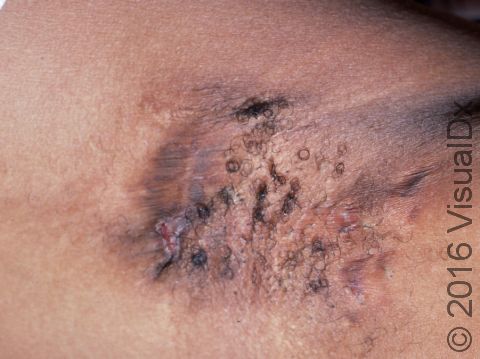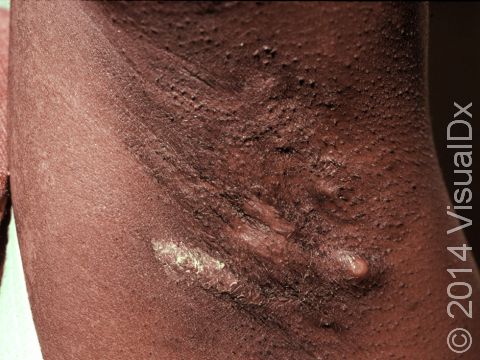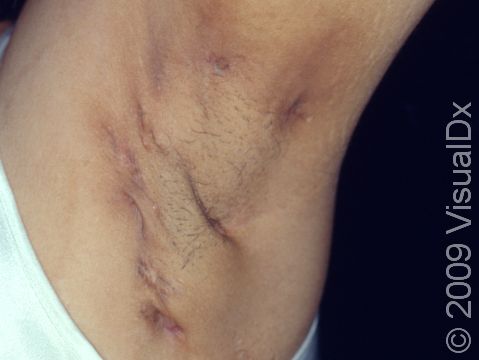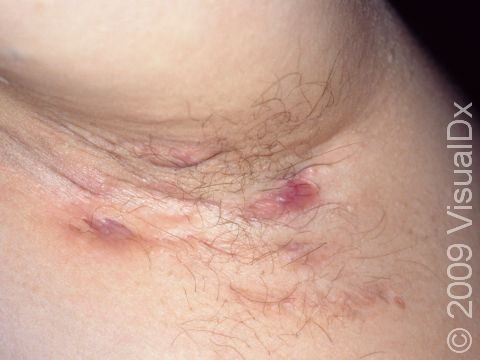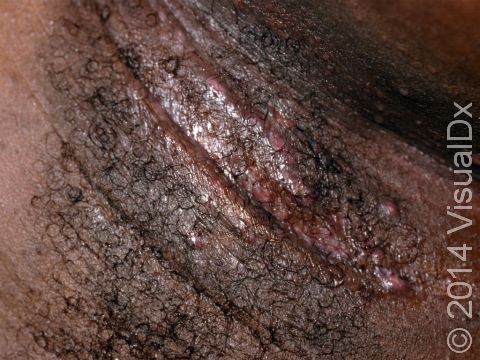Hidradenitis Suppurativa
Hidradenitis suppurativa is a chronic condition of clogged sweat glands that leads to inflammation of the skin in areas such as the groin, underarms, underneath the breasts, and in between the buttocks. It most commonly appears as multiple large nodules (solid, raised bumps), abscesses (red, swollen, warm, tender bumps or lumps with pus inside), and tunnels (holes in the skin that may contain fluid such as pus) in these areas. The nodules and abscesses gradually get larger and drain pus. After multiple bouts of this cycle of plugging, enlargement, and drainage, there may be tunnel formation under the skin and scarring. Pain is the most common symptom, but individuals with hidradenitis suppurativa also report itchy lesions, a foul odor coming from lesions when they drain pus, feeling tired, and joint pain.
While there is no cure for hidradenitis suppurativa, you can work with your medical professional to treat existing lesions and prevent new ones.
Who's At Risk?
Hidradenitis suppurativa usually starts soon after puberty and continues into adult life. It is more common in women and in Black individuals. Hair removal from shaving or using depilatories, deodorants, and irritation from anything rubbing against the affected area can worsen the condition. Hidradenitis suppurativa is often associated with smoking, obesity, diabetes, and hormonal changes. Additionally, it often runs in families.
Signs & Symptoms
The groin and underarms are often affected. There may also be lesions between the buttocks or under the breasts due to friction from skin rubbing together, which is why people who are obese are more predisposed to this disease.
The lesions of hidradenitis suppurativa are firm, tender bumps. In lighter skin colors, the lesions are often pink or red. In darker skin colors, the lesions may appear brown, purple, or gray. There may also be tunneling under the skin and scar formation. There may be pairs of blackheads within scars, and the lesions may drain pus. Hidradenitis suppurativa lesions are rarely seen on the trunk of the body or on the scalp or legs.
Some people may experience only one or a few lesions, while others may have severe disease, affecting many areas.
People with hidradenitis suppurativa may experience depression and anxiety, especially if the disease is severe or chronic.
Self-Care Guidelines
Make sure to wash any inflamed, draining areas of hidradenitis suppurativa with antibacterial soap, and then apply an antibiotic ointment (Neosporin) and clean bandages. If there is a large amount of drainage, change the gauze pads and dressings often. Warm compresses and ibuprofen (Advil, Motrin) can help reduce the swelling. Avoid wearing tight-fitting clothing to help prevent further irritation.
Weight loss may decrease lesions by decreasing skin folds and, thus, friction on the skin. Smoking should be avoided.
Treatments
Your medical professional may prescribe a topical antibiotic lotion or swab for mild areas, or they may prescribe a long course of oral antibiotics. You may be given an injection of steroids into the deep, painful hidradenitis suppurativa lesions. If hormonal fluctuations are thought to be contributing to the condition, you may be prescribed hormonal therapy. Other treatments include a retinoid such as acitretin (Soriatane) and biologic therapies such as adalimumab (Humira).
Surgical removal is often the ideal treatment for severe cases of hidradenitis suppurativa with scarring and tunneling.
Visit Urgency
Some mild cases of hidradenitis suppurativa can be treated with self-care measures. Healing of individual lesions takes about 1-2 weeks. Make sure to seek medical care if you are not able to control the pain with ibuprofen and warm compresses or if the condition is making you feel sad or anxious. Medical treatment may be necessary if the condition appears in multiple areas or continues to come back (recur). If there is excessive pain, excessive drainage, red streaking, you have a fever, or there are any other factors that may indicate there is an infection, see your medical professional. If you have been given antibiotics and the area does not improve within a few days, return to your medical provider.
References
Bolognia J, Schaffer JV, Cerroni L. Dermatology. 4th ed. Philadelphia, PA: Elsevier; 2018.
James WD, Elston D, Treat JR, Rosenbach MA. Andrew’s Diseases of the Skin. 13th ed. Philadelphia, PA: Elsevier; 2019.
Kang S, Amagai M, Bruckner AL, et al. Fitzpatrick’s Dermatology. 9th ed. New York, NY: McGraw-Hill Education; 2019.
Paller A, Mancini A. Paller and Mancini: Hurwitz Clinical Pediatric Dermatology. 6th ed. St. Louis, MO: Elsevier; 2022.
Last modified on June 1st, 2023 at 2:05 pm

Not sure what to look for?
Try our new Rash and Skin Condition Finder
